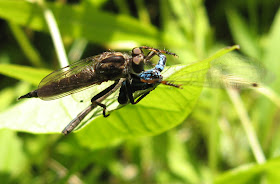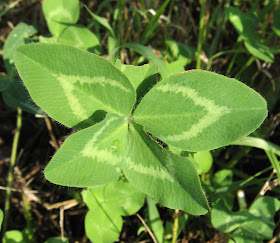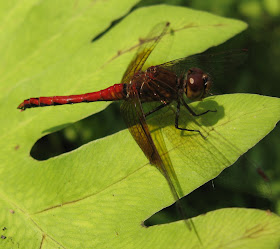There was no choice but to take the following two pictures while this dragonfly was on the wing, because, much like the large darners, these guys fly and fly and fly ... This one seemed to prefer patrolling back and forth along the margin of the lake, staying a couple of feet above the water where there were no emergent plants. I expect to get a better photo in the near future as these dragonflies are very curious, stopping to hover in one place for a few seconds while looking me over (maybe wondering if I'm edible?)
The colors and shape of the wings are clear enough to identify this as a Wandering Glider (Pantala flavescens), having the reputation of being the most widely distributed dragonfly in the world. As their name suggests Wandering gliders are migratory and I don't see them every year.


Rather than staying on the wing for long periods like darners, dragonflies such as the skimmers below usually prefer to sit on a favourite perch, darting out to snatch smaller insects that happen to fly past.
Slaty Skimmer (Libellula incesta), male

Twelve-spotted Skimmer (Libellula pulchella), male


Left: Widow Skimmer (Libellula luctuosa), male
Right: Eastern Pondhawk (Erythemis simplicicollis), female

Widow Skimmers are gregarious and tame. They don't startle easily, making them good subjects for beginners to photograph. This female Widow Skimmer didn't mind posing for a mug shot.

An Eastern Pondhawk (Erythemis simplicicollis) eating dinner. I've found that dragonflies seem to pay less attention to their surroundings when they are busy chowing down, and this is a good time to sneak up on them for a close shot. This is a young male, some green is still visible on his thorax. As he ages the pale blue pruinosity typical of the adult males will cover his entire body.

An even younger male, he's only developed a bloom on his abdomen.

Damselflies and dragonflies belong to the order Odonata, which means "toothed jaws". This female Tule Bluet (Enallagma carunculatum) is eating what appears to be a small whirligig beetle. The beetle's hard exterior wings aren't much defense against the damselfly's natural cutlery.

A female Powdered Dancer (Argia moesta) consuming its prey.

When dragonflies aren't hunting and eating they're busy starting the next generation. The following two photos are mating pairs of Halloween Pennants (Celithemis eponina) in the wheel position. Much like their table manners, there's no civility or consideration when it comes to dragonfly love ... the female's eyes and head may end up getting gouged and punctured by the male's claspers. While this may seem terrible from our human perspective, evolution is all about whatever works to perpetuate the species and according to the fossil record dragonflies have been around for a few hundred million years.


Mating White-faced Meadowhawks (Sympetrum obtrusum)

As often as not, the hunter becomes the hunted; this is a Robber Fly having a bluet for lunch. Robber flies are in turn pursued by the damselflies larger odonate cousins. Robber flies and dragonflies lead similar lives and exploit related niches in the ecosystem. Although a true fly possessing only one pair of wings, note how the robber fly's appearance ... the large compound eyes, hairy basket-like legs, and long wings and abdomen ... tends resemble that of a dragonfly. Now that's evolution in action.



























































